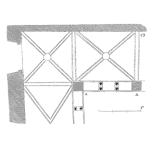
It has been awhile since Ike…so I figured this would be an appropriate time to post on hurricane risks.
During a hurricane plant equipment can be damaged both by high winds and flooding. For example, the majority of plant equipment damage caused by Hurricane Rita (2005) was wind related, whereas more flood-related damage was reported during Hurricane Ike (2008).
This post focuses on damage to Above Ground Storage Tanks (ASTs) from flooding.
Damage from Flooding
ASTs in coastal areas are often protected by levees, making it necessary for the levee to fail in order for the water to damage the equipment. In some cases, the levee is breached by the floodwater, and in others, the water simply rises high enough to overtop the levee.
Rising waters exert a buoyant force on the AST, potentially breaking it loose from its anchorage to float away. Therefore, the heavier the equipment the less likely it is to float and be displaced. Typically, flood damage is more common in ASTs that are standing on ground without any anchorage or support. Upon flooding these ASTs can be carried along with the flowing water. As the tank floats on water it may damage the piping or associated systems. This rupture of pipeline or tank may lead to a large liquid spill and consequently considerable costs in environmental remediation. Another significant cost incurred from equipment damage is from business interruption. Usually, the environmental remediation and business interruption costs will dominate the costs incurred to repair equipment damage.
A Few Practices to Avoid Flood Damage
- If a storage tank is empty and clean, open the man-way cover. This will fill the tank with flood water increasing liquid level and provide protection against wind and flood damage
- Increasing the freeboard diked area will provide additional protection to storage tanks from flooding
 Ask a question or send along a comment.
Please login to view and use the contact form.
Ask a question or send along a comment.
Please login to view and use the contact form.
Leave a Reply